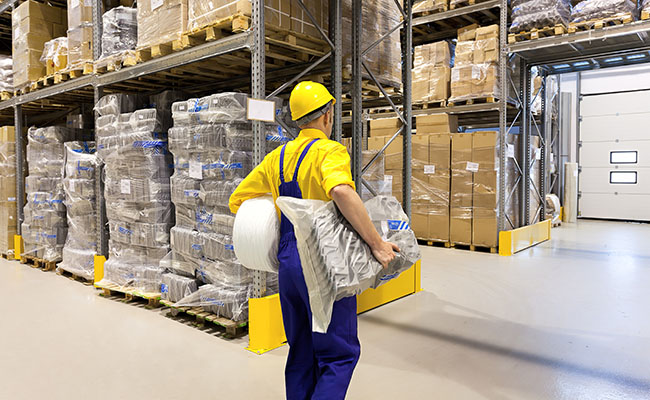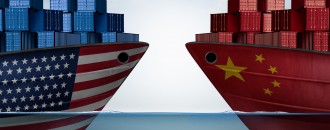
'Abolition of road permits, entry taxes can ensure the agility in distribution system'
Interview by Sisir Pradhan | The Dollar Business  The Dollar Business (TDB): Give a brief outline about your logistics, especially warehousing capabilities in India and other parts of the world Shrichand Chimnani (SC): DB Schenker is one of the leading global 3PL (third-party logistics) logistics service providers. We offer seamless end-to-end supply chain solutions to regional and global customers through our hubs across the globe. In India, we have our presence in 36 locations with 61 facilities including strategically located 30 Schenker Logistics Centers (SLCs) with more than 1,300 workforce dedicated to support the customer-specific requirements. TDB: How critical role a warehouse can play in the entire logistics value chain for a freight forwarding company as well as its clients? SC: Warehouses play a vital role in the overall supply chain process. Due to continuing globalisation and changes and challenges occurring in such areas as reverse logistics, environmental sustainability, information technology, and overall supply chain integration, the strategies, roles and responsibilities for warehouses are evolving. Distribution Centres (DCs) provide a dual value-added role making supply chains more efficient and warehouses help freight forwarders to provide end-to-end services to customers. DCs also make the supply chain more effective by consolidating products for shipment to customers, reducing transportation costs, and performing a broad range of value added services (e.g. branding, labelling, assembly, packaging, kitting, and reverse logistics). However, strategic placement of DCs ensures the positioning of products and services close to major markets and customers which reduces the lead time for moving the goods from warehouse to the customers.
The Dollar Business (TDB): Give a brief outline about your logistics, especially warehousing capabilities in India and other parts of the world Shrichand Chimnani (SC): DB Schenker is one of the leading global 3PL (third-party logistics) logistics service providers. We offer seamless end-to-end supply chain solutions to regional and global customers through our hubs across the globe. In India, we have our presence in 36 locations with 61 facilities including strategically located 30 Schenker Logistics Centers (SLCs) with more than 1,300 workforce dedicated to support the customer-specific requirements. TDB: How critical role a warehouse can play in the entire logistics value chain for a freight forwarding company as well as its clients? SC: Warehouses play a vital role in the overall supply chain process. Due to continuing globalisation and changes and challenges occurring in such areas as reverse logistics, environmental sustainability, information technology, and overall supply chain integration, the strategies, roles and responsibilities for warehouses are evolving. Distribution Centres (DCs) provide a dual value-added role making supply chains more efficient and warehouses help freight forwarders to provide end-to-end services to customers. DCs also make the supply chain more effective by consolidating products for shipment to customers, reducing transportation costs, and performing a broad range of value added services (e.g. branding, labelling, assembly, packaging, kitting, and reverse logistics). However, strategic placement of DCs ensures the positioning of products and services close to major markets and customers which reduces the lead time for moving the goods from warehouse to the customers.
 Shrichand Chimnani, Director - Logistics India, DB Schenker
Shrichand Chimnani, Director - Logistics India, DB SchenkerTDB: What kind of noticeable change has come to the Indian warehousing sector after the entry of organised and internationally acclaimed logistics companies like yours? SC: DB Schenker in India today has the strong capability to act as a total supply chain solution provider, facilitating international freight, customs clearance, help in storage by way of our warehousing network and offer solutions for domestic distribution with a strong network of sub-contractors. DB Schenker is one of few logistic providers in the world that can be trusted for such a move. Our mission is to provide end-to-end logistics for everything from procurement and manufacturing to fulfilment and aftermarket support, with innovative solutions for moving everything from one part to another. DB Schenker has an integrated suite of services that bridges the gap between production and final delivery. As a supply chain specialist, we provide Vertical Market specific solutions to the clients mixed with value-added services. This approach includes everything from inbound and manufacturing supply management, to distribution of finished goods, and the support of aftermarket activities, optimizing the business resources and leveraging a range of cost optimization initiatives. TDB: If you have to point out couple of key differentiators or business practices between the logistics sector and warehouses in India and in the West, what are they? Moreover, how the demand/requirement from your clients in terms of warehousing/storage has changed over the years? SC: Warehouses in the West are highly efficient and advanced in terms of using tools such as RFID, barcode and scanner for automatic data collection & Warehouse Management Systems (WMS). Such extensive use of technology gives data quite accurately. Multi Modal Logistics hubs (MMLH), integrated logistics park and Free Trade Warehousing Zones are at a greater productivity and efficiency level than the developing market. Clients now look forward to more organised and efficient operations in terms of timely pick-up and delivery, hygienic warehouses coupled with value-added services at one stop shop. There has also been increasing demand for technology-driven solutions, e.g. GPS, real-time cargo delivery updates etc. Clients now are inclined towards variable price model which caters to their various requirements rather than fixed price model which leads to expanded horizon. TDB: In the last decade or so what kind of technological innovation or implementation that you have witnessed in this sector? SC: In the last decade, technological innovation has taken shape in the form of Greenfield setups, energy efficient sites, vehicle and fleet efficiency, warehousing operational efficiency by way of implementing automated processes like fast data collection techniques and even advanced version of WMS, automation by conveyers, chutes, vertical racking, mechanised storage and retrieval system. TDB: With the increasing acceptability of e-commerce and online retails stores in the country, there is a rising demand to deliver goods to some of the remote parts of the country and even within a fixed time frame. And also in this business there is a requirement for reverse logistics as well. How the (logistics) sector is adjusting itself to fulfil their demand and has warehouses a role to play here? SC: With the increasing demand to deliver goods in remote areas, e-commerce companies are tying up with logistics companies focused on e-commerce business and product deliveries with tight TAT (Turn Around Time). Few e-commerce companies have even developed their own logistics arm and few have invested in 3PL to handle these challenges and also tying up with number of players based on their strength on locations. E-commerce companies are also setting up small warehouses in metros to deliver goods faster. The 3PL organisations are investing in technologies, people and storage medium to improve and speed up the warehouse activities and reduce the order to manifest time so that goods are available on time for transporters. TDB: In recent times there has been a surge in domestics cargo, air cargo to be specific, what kind of challenges it raises for the logistics sector? And even during festive season the number of consignments multiplies. How the industry handles this kind of seasonal demand for more storage and cargo handling space? SC: Shorter transit time in the case of air cargo leads to challenges like moving them out quickly through an airport. Considerations for improvement of transit times and handling are well taken care of by modern warehouses as these are equipped with loading docks to speed-up truck turnarounds, and export facilities for scanning, inspection, building palettes and gathering the cargo for specific flights. Separate facilities for imports have offices and inspection areas to facilitate customs clearance procedures and to allow for segregation of cargo into truckloads. In the logistics value chain, there is always focus on forecast planning which ensures that carriers review their connectivity to meet the needs of the distribution. TDB: One of the issues raised by warehouse users is there are very limited number of customs-bonded warehouses and this is a reason for longer dwelling time at airports. Do you agree? SC: There are a limited number of public custom-bonded warehouses to cater to growing businesses which lead to longer dwelling time at the airport. However, the scenario is now changing as 3PLs are constructing their own private custom-bonded warehouses and also with the advent of FTWZ (Free Trade and Warehousing Zones), this bottle-neck is being reduced as they provide quick customs clearance along with other value-added services. TDB: Apart from e-commerce, what are the other factors that you see fuelling the growth of logistics and warehouse sector in the domestic market? SC: With the changing mind-set of customers, they have got the confidence in the logistics service providers. Moreover, they want to focus on their core-business and outsource these activities to 3PLs, which also add flexibility to their operations with the expansion of their business. TDB: On the policy and taxation front, what are the changes that you would like to see? SC: In addition to rationalization of taxes, it is equally important that the government abolishes the road permit system and entry taxes which will ensure the agility in the distribution system and drastically reduce the transit time and vehicle utilization. TDB: Going forward how do you see the future of warehousing sector in India, the challenges before the sector and how the industry is gearing up or has tackled these challenges? SC: The logistics industry in India is evolving rapidly because of the interplay of infrastructure, technology and new types of service providers who are able to help its customers by providing effective services. Changing government policies on taxation and regulation of service providers also play an important role in this process. Global logistics industry has challenges like high costs of operations, low margins, shortage of talent, infrastructural bottlenecks, demand from clients for investing in technology and providing one-stop solutions to all their needs, and consolidation. Most of these warehouses are not equipped with automated processes and security systems. Majority of the operators of these warehouses are also small to mid-sized entrepreneurs with limited investment capacity. With emerging requirements of integrated logistics, provision of transportation hub, value addition etc, large logistics park are being developed. TDB: Rising real estate prices are a concern for warehousing sector. What measures have to be taken to keep costs under control on this front? SC: Overall rising cost has a very negative impact on the growth of the industry. From logistics perspective, the Warehouse rental costs have to come down in the long run. Various impacts that some new strategic locations would bring in are:-
- Automation in big warehouses which is not possible in smaller ones due to cost feasibility
- Consolidate and merge State warehouses to 7-8 Regional warehouses to cater the end customer
- Economies of large scale operations
- Process Optimization
- 3PL Services with more focus on value added services.
TDB: What kind of impact do you see for the warehousing sector if GST comes to effect? SC: GST will transform the current complex tax regime and ease the tax woes of the industry. It helps in reducing the logistics cost by consolidation and re-organisation of supply chain methods depending upon the requirement and organisation capabilities. One of the most significant impacts will be the elimination of tax warehouse into fewer, larger ones which will bring positive results for the industries, most significantly with consumer durables which have a large scope for consolidation. Dismantling of the tolls across highways and state highways will improve efficiency and additional saving through lower freight and inventory cost. TDB: Logistics cost as a percentage of GDP in India, compared to the West is almost double. What could be done or needs to be done to bring it down. Moreover, have warehouses any role to play in this aspect? SC: While in absolute terms, industry spending on logistics in India is low - the relative spend is high. India spends 13% of GDP on logistics which is more than what the US – 9.5% and Germany – 8% is spending. Some of the important drivers that can reduce the logistic cost:-
- Supply chain decisions are driven by Tax issues rather than supply chain efficiencies
- Manufacturing sites largely guided by Tax incentives by way of tax deferrals & exemptions
- Working capital blocked in taxes, which are levied at the stage of production
- Warehouse setup to be done at every state to avoid CST (Central Sales Tax)
- Time consuming for inter-state transportation.
November 17, 2015 | 5:36pm IST.





 to success.
to success.